Site Menu:
| This is an archived Horseadvice.com Discussion. The parent article and menus are available on the navigation menu below: |
| HorseAdvice.com » Diseases of Horses » Lameness » Localizing Lameness in the Horse » |
| Discussion on Bilateral front foot lameness | |
| Author | Message |
| New Member: cvmb95 |
Posted on Thursday, Dec 6, 2007 - 8:33 pm: I have a 17.1 hand ISH, 9 yo. Have had for 3 years and has never been lame. Went to a new barn with a new farrier. 3-4 months at the new barn and the farrier started mentioning that my horses feet were tender. They also became soft and crumbly (realized after talking to old farrier that happens when his feet stay wet - new pasture very wet). Then he pulled a shoe and possibly popped a splint left front. Was on rest for 1-2 months. Came out sore on left front (stabbing motion into ground). Xrays ok except for thin sole and no heel. Blocks of his left foot resolved the left lameness and revealed lameness on the right. New farrier - wedges, with "pink stuff" impression material and leather pads. Seemed better - could ride 10-15 min at trot before he got sore. 10 weeks later had feet done (same way)and now is short strided and stiff on both front legs. Not sure if this is expected? Should I keep riding? Should I xray again? Does he just need more time? Is something else going on? |
| Moderator: DrO |
Posted on Friday, Dec 7, 2007 - 7:14 am: Welcome C Buono,If the diagnosis is lameness because of thin soles many of your questions addressed, including important additional information, at Diseases of Horses » Lameness » Diseases of the Hoof » Poor Horn Quality: problems with the wall and soles. The specific questions about your horse require direct examination to make good judgements so should be addressed to your veterinarian. The real question is why has this occurred. You certainly paint a picture of a horse that had healthy feet that has gone rapidly down hill. Unless you believe this is beyond the control of the barn, environment, and/or farrier I would consider moving back to the old barn and the old farrier. If you post some good images of the feet, laterals and solar surface if possible, we may have other recommendations to consider. DrO |
| Member: deedles5 |
Posted on Friday, Dec 7, 2007 - 11:33 am: Get a proper barefoot trim and consider boots for his tender soles. I would evaluate your feeding program as well. He may need to be restrictedto low sugar grass hay, no grain, and whatever minerals are missing in the hay. I just went through almost the identical problem and my horse is now sound. With no radiographic evidence he had laminitis. Was diagnosed as having heel pain, was toe walking, and getting worse. Instead of doing a navicular shoeing job, I got a barefoot trim from a Ramey type trimmer. Two months later a red lamellar wedge grew out, and he is walking flat. Good luck, it is tough. |
| New Member: smacemon |
Posted on Friday, Dec 7, 2007 - 12:17 pm: (I'm not new to HA, just never posted...)With a 19yo Appendix QH, navicular changes and arthritis, I've become very sensitive to foot issues. Everything you mention - thin sole and no heel, crumbly soles - could be due to a change in farrier compounded by wet pasture. When you say "10 weeks later had feet done the same way", is that the first-next shoeing, or the second? 10 weeks is a really long time between trims - with or without shoes. Lukas gets trimmed and shoes re-set every 5-6 weeks - sometimes he needs a lot trimmed, sometimes not so much. I suspect many horses would be a bit tender-footed after going from really long, to just trimmed. If the sole is over-pared, then more tenderness. We had a problem with thin sole and no heel after I pulled his shoes and had a barefoot trimmer work on him - she took of more of his sole than she left...we were not a happy campers. (For those who have had miracles with barefoot trims - I agree. Find a VERY competent farrier and talk to their other clients before you let them touch your horse! Dr. O's article-Horn quality problems- mentions these problems specifically in relation to shoeing that leaves long toes and low heels. I'd get some boots and use them, right lightly for awhile, see if your old farrier will work at the new barn, or, as Dr O suggests, get your horse back to the old place where his feet were in good shape. Shirley |
| Member: imogen |
Posted on Friday, Dec 7, 2007 - 1:55 pm: An ISH, especially one that big, on wet pasture needs shoes in my experience... I think you breed 'em with different hoof quality in the USA than we do here. I have only met one pony here in 15 years that had the hoof quality to be ridden barefoot in our damp climate.Imogen |
| New Member: cvmb95 |
Posted on Friday, Dec 7, 2007 - 2:41 pm: Thanks for all the advice! This is my first post on this site. Unfortunately, the old barn no longer is in business (moved South). The old farrier retired. I live in a rural area so there aren't many choices of farriers. I supposedly have the best right now. The vet and farrier wanted to let him go 10 weeks so he could grow some heel and sole, which he did - about 1/4 inch of heel. His feed has not changed at the new barn - gets pellets- no sweet feed. I will try to post some pictures of his feet before and after. He was imported from Ireland at 4 years ago and has always had shoes all around. Will check out the article. Thanks. |
| New Member: cvmb95 |
Posted on Friday, Dec 7, 2007 - 5:17 pm: Here are his xrays from about 10-12 weeks ago after the first corrective shoeing. Also included picture of his feet last year before any problems.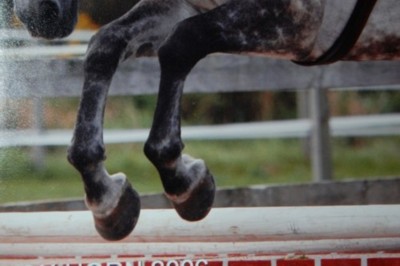 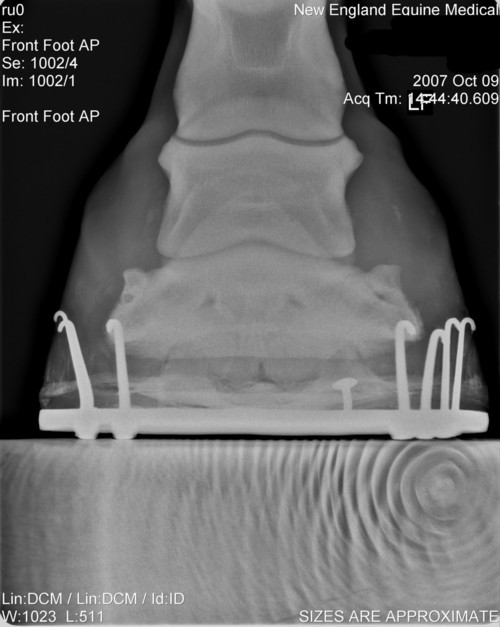 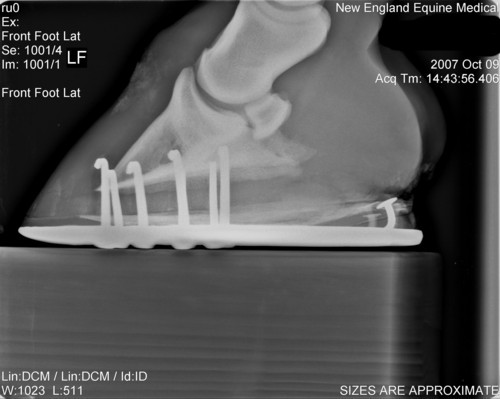 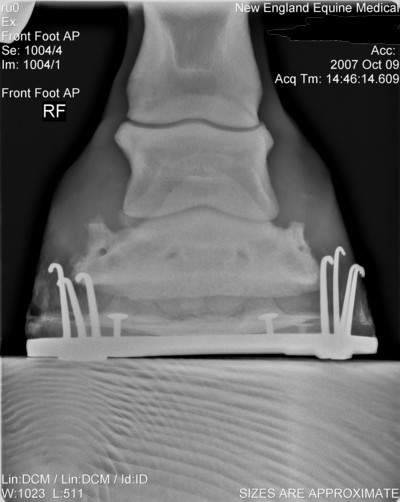 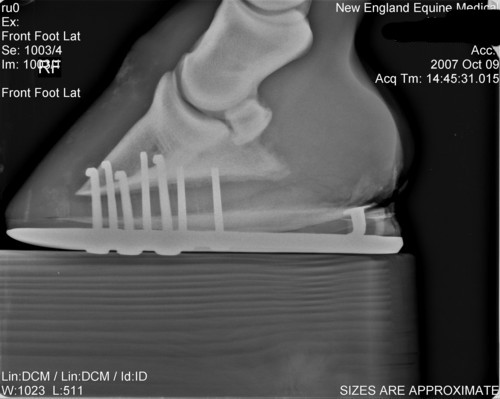
|
| Member: deedles5 |
Posted on Friday, Dec 7, 2007 - 8:34 pm: The barefoot trimming protocol we follow does not involve removing any sole whatsoever, unless it is chalky and loose. Was your barefoot trimmer a Strasser advocate? They have a tendency to cut for concavity.My gut feeling is that he does not need to grow more heel but should have a more ground parallel coffin bone. I would bring his toe farther back and rocker the toe. There is a lot of mechanical stress on the tip of that coffin bone. |
| Member: juliem |
Posted on Friday, Dec 7, 2007 - 8:52 pm: I agree, the breakover with these shoes looks too far forward which will set the horse up for underrun heels. Then a farrier inexperienced with barefoot trimming will say "needs to grow more heel" when in actuality, the heels need to be taken back to the widest part of the frog (using the live sole plane as a guide) and the breakover moved back so that it is more underneath the tip of the coffin bone. |
| New Member: cvmb95 |
Posted on Friday, Dec 7, 2007 - 10:08 pm: Thanks for your thoughts. He has never been barefoot. Always had front and back shoes. He is not standing in the xrays if that makes a difference. His foot is up on a block which may affect the angle of the coffin bone? I spoke to his old farrier and he is shocked about the state of his feet. He recommended egg bar shoes. He thinks the wedge does not promote heel growth. |
| Moderator: DrO |
Posted on Saturday, Dec 8, 2007 - 6:57 am: Hello Everyone,Though I will measure it later, the coffin bone' solar surface angle is acceptable as shod and it should be noted this value does vary greatly among normal horses. Note this is not the same as saying there has been no rotation since the farrier has adjusted the angle with a pad and could have rasped the front wall parallel. We just do not have the information to judge. Breakover, which is about a cm or two in front of the tip of the coffin bone, looks pretty good though I would prefer a lot more slope to the rocker like that seen in a natural balance shoe. The breakover point of these shoes would disappear on soft ground as the shoe sinks and breakover moves forward to the tip of the foot. Julie would then be right with breakover well too far forward. Although these images demonstrate the lack of heel and the attempts to correct it, at least the appearance 60 days ago, I would still like to see current images of the foot and sole itself. Your old farrier is correct if the horn quality of the wall is poor and/or the wedges overload the heels. The wedges will distort and breakout poor quality horn and pressure overload slows the growth of the wall at these points. I also do believe egg bars help support poor quality heels when used with proper trimming principles and horn care for more on the trimming see Diseases of Horses » Lameness » Diseases of the Hoof » Correcting Long Toe Low Heel Foot Conformation. DrO PS: perhaps your retired farrier would agree to consult with the current farrier on fixing this problem? |
| New Member: cvmb95 |
Posted on Saturday, Dec 8, 2007 - 2:39 pm: Thanks Dr Oglesby for you input. Yes, the old farrier has agreed to consult the next time his feet are due to be done. I lightly rode General today and he actually seemed better. Not short strided in front. My trainer rode him to and she thought he felt fairly even up front. All she felt different was that he was not coming from behind since he is not conditioned. The farrier thinks perhaps he needed time to get used to the winter/borium shoes?? Will see how he is tomorrow. I have to travel three hours for xrays. Do you think it is worth it? I don't want any permanent damage if the shoeing is not correct, but if he is going ok perhaps wait on them for now?? Thanks. |
| Moderator: DrO |
Posted on Sunday, Dec 9, 2007 - 7:50 am: Without examining the horse C Buono I cannot judge the need for further radiography so this is a call your vet and farrier will need to make. What I am interested in are images of the foot and sole itself, not radiographs.DrO |
| Member: cvmb95 |
Posted on Sunday, Dec 9, 2007 - 8:49 am: I don't know if you can tell much from this picture. It was when he was starting to have problems - compared to the previous picture above. I can try to get new ones although won't be able to do the sole until he is shod again in about 5-6 weeks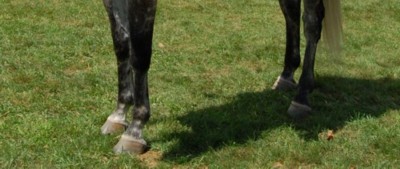 . .
|
| Member: cvmb95 |
Posted on Sunday, Jan 27, 2008 - 9:10 pm: Update - General is doing much better thanks to the corrective shoeing. He has grown about 1/4 inch of heel and is no longer tender. We are walk, trotting without any lameness!! |
| Moderator: DrO |
Posted on Monday, Jan 28, 2008 - 6:31 am: That is excellent C Buono,DrO |
Horseadvice.com
is The Horseman's Advisor
Helping Thousands of Equestrians, Farriers, and Veterinarians Every Day
All rights reserved, © 1997 -
is The Horseman's Advisor
Helping Thousands of Equestrians, Farriers, and Veterinarians Every Day
All rights reserved, © 1997 -
